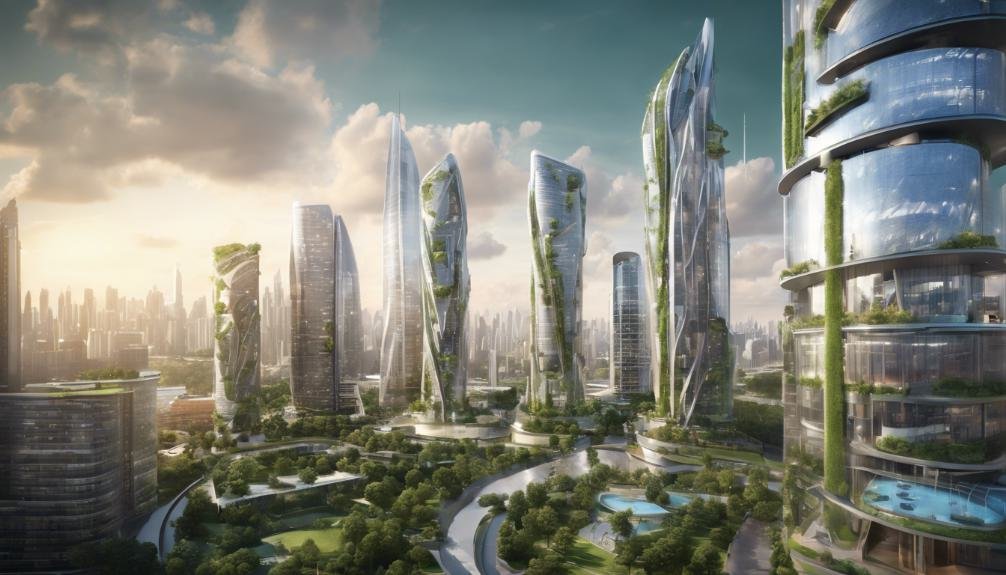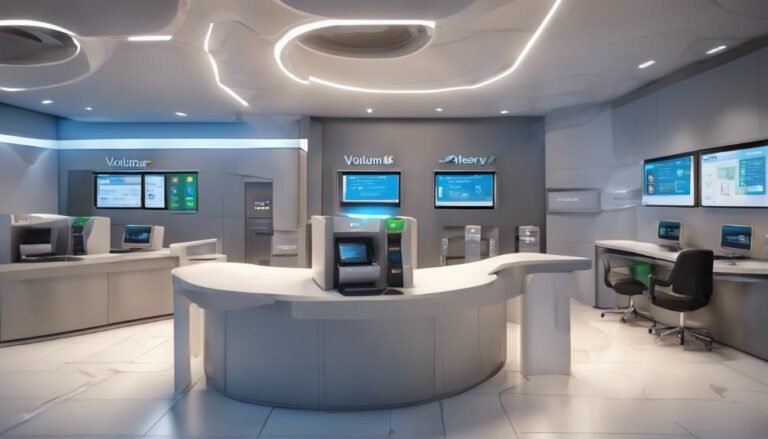Real Estate Investment Trends for 2024
As you navigate the landscape of real estate investments in 2024, a tapestry of trends unfolds, offering glimpses of what lies ahead in this dynamic sector. From the fusion of technology with traditional practices to the evolving preferences in housing choices, the domain of real estate is poised for intriguing developments. Stay tuned to uncover how these trends may shape your investment decisions and strategies in the ever-evolving world of property markets.
Key Takeaways
- Continued integration of blockchain and smart home tech for secure, efficient investments.
- Growing emphasis on sustainable properties with green initiatives and energy-efficient features.
- Rise of co-living spaces for cost savings and community-oriented living arrangements.
- Investment in affordable housing for stable cash flow, community impact, and future growth.
- Market trends include technology integration, sustainability, mixed-income developments, and government incentives.
Emerging Proptech Innovations
Explore how emerging Proptech innovations are reshaping the real estate investment landscape in 2024, offering investors unprecedented opportunities for growth and efficiency.
The integration of smart homes and blockchain technology has revolutionized the way real estate investments are managed. Smart homes integration allows for enhanced security, energy efficiency, and convenience for tenants, thereby increasing property value. Additionally, blockchain technology ensures transparent and secure transactions, reducing fraud and streamlining the investment process.
Digital property management systems powered by AI solutions have also become instrumental in optimizing real estate investments. These systems provide real-time data analytics, predictive maintenance insights, and personalized tenant experiences. By automating routine tasks and offering data-driven decision-making support, AI solutions enhance operational efficiency and asset performance.
Investors can now make more informed decisions, mitigate risks, and maximize returns through these advanced technologies. As the real estate industry continues to embrace Proptech innovations, staying ahead of these trends will be essential for success in the evolving investment landscape of 2024.
Sustainable Property Investments
You need to pay attention to Green Building Initiatives, which are gaining significant traction in the real estate market.
Incorporating eco-friendly features and meeting energy efficiency standards can enhance the long-term value and sustainability of your property investments.
These trends not only align with environmental goals but also appeal to a growing segment of socially conscious tenants and buyers.
Green Building Initiatives
How will the integration of green building initiatives impact the sustainability and profitability of real estate investments in 2024?
The incorporation of green technology and renewable energy sources in real estate projects is set to revolutionize the industry in the coming year. With a growing emphasis on sustainability, properties that prioritize energy efficiency and eco-friendly practices are becoming increasingly attractive to investors.
Green building initiatives not only contribute to reducing the carbon footprint of properties but also lead to long-term cost savings. By harnessing renewable energy sources such as solar power or geothermal systems, real estate investors can lower operational expenses and enhance the overall value of their assets.
Additionally, the market demand for environmentally conscious properties is on the rise, driving up property values and rental rates for sustainable buildings.
In 2024, the synergy between green technology and real estate investments won't only promote environmental conservation but also offer lucrative returns for those who embrace sustainable property development.
Eco-Friendly Features
The integration of eco-friendly features in sustainable property investments in 2024 presents a compelling opportunity for real estate investors seeking long-term value and environmental impact. Green technology and sustainable design are at the forefront of this trend, with innovations that not only reduce the carbon footprint of buildings but also enhance their overall efficiency and appeal.
Green technology, such as solar panels, smart thermostats, and energy-efficient appliances, are becoming standard features in eco-friendly properties. These technologies not only lower energy costs for property owners but also contribute to a more sustainable environment by reducing reliance on fossil fuels.
Furthermore, sustainable design principles are being increasingly incorporated into property developments, focusing on factors like natural lighting, passive heating and cooling systems, and use of recycled materials. These design elements not only promote energy conservation but also create healthier and more comfortable living spaces for residents.
Incorporating green technology and sustainable design into real estate investments not only aligns with growing environmental consciousness but also positions properties for long-term value appreciation and market competitiveness in the evolving real estate landscape of 2024.
Energy Efficiency Standards
Implementing strict energy efficiency standards is essential for ensuring the sustainability and long-term viability of property investments in 2024. With the increasing focus on environmental responsibility and cost savings, energy efficiency regulations have become paramount in the real estate sector.
Sustainable design trends are shaping the way properties are built and operated, emphasizing the importance of reducing energy consumption and carbon footprints.
Green building certifications, such as LEED (Leadership in Energy and Environmental Design) and BREEAM (Building Research Establishment Environmental Assessment Method), are gaining prominence as investors seek properties that adhere to high energy efficiency standards. These certifications not only validate a property's eco-friendly credentials but also enhance its market value and appeal to environmentally conscious tenants.
Incorporating eco-friendly construction techniques like passive solar design, advanced insulation, and energy-efficient HVAC systems can notably improve a property's energy performance. By prioritizing energy efficiency standards and embracing sustainable building practices, real estate investors can future-proof their investments, mitigate risks associated with climate change, and contribute to a greener, more sustainable built environment.
Rise of Co-Living Spaces
You can't ignore the shared living benefits that co-living spaces offer in regards to cost savings and social interactions.
These spaces aren't just a housing solution but also a response to urban affordability challenges faced by many.
The rise of co-living signifies a shift towards community-oriented living arrangements that cater to the needs of a new generation of tenants seeking more than just a place to live.
Shared Living Benefits
Enhancing social connections and cost-efficiency, co-living spaces are reshaping the real estate investment landscape for 2024. Co-living offers numerous benefits for both investors and tenants. Here's why co-living spaces are gaining traction:
- Financial benefits: Co-living provides an attractive option for individuals looking to save on housing costs. By sharing common spaces and amenities, tenants can enjoy a more affordable living arrangement compared to traditional housing options.
- Social connections: Co-living fosters a sense of community and belonging. Living with like-minded individuals allows for increased social interactions, networking opportunities, and support systems. This social aspect is particularly appealing to young professionals and digital nomads seeking a balance between work and social life.
- Flexibility: Co-living spaces often offer flexible lease terms, allowing tenants to adapt their living situations to changing circumstances easily. This level of flexibility appeals to individuals who may not want to commit to a long-term lease or prefer a more dynamic living environment.
Urban Affordability Solution
The rise of co-living spaces as an urban affordability solution reflects a significant shift in real estate investment strategies for 2024. With the ongoing housing crisis in many urban areas, innovative solutions like co-living spaces are gaining traction. Urban design plays an essential role in shaping these spaces to maximize efficiency and functionality while promoting a sense of community among residents.
Co-living spaces offer a practical solution to the housing crisis by providing affordable options for urban dwellers facing skyrocketing rents and limited housing choices. By sharing common areas and amenities, residents can enjoy cost savings while still experiencing high-quality living standards. This trend highlights the growing importance of sustainable and inclusive urban design practices that cater to the needs of a diverse population.
As real estate investors pivot towards more socially conscious projects, co-living spaces present a viable opportunity to address the affordability challenge in urban areas. By embracing this trend and incorporating thoughtful urban design principles, investors can contribute to creating thriving communities that prioritize accessibility, affordability, and sustainability.
Community-Oriented Living Spaces
Co-living spaces have emerged as a transformative solution in response to the pressing affordability challenges faced by urban residents in 2024. These innovative living arrangements not only offer a more cost-effective housing option but also foster a sense of community and belonging among residents.
Here are three key reasons why co-living spaces are gaining popularity:
- Community Engagement: Co-living spaces provide residents with opportunities to interact, collaborate, and build meaningful relationships with like-minded individuals. This communal aspect addresses the growing need for social connections in urban environments, enhancing overall well-being.
- Inclusive Design: Co-living spaces are designed to be inclusive, catering to diverse demographics and lifestyles. By prioritizing accessibility and flexibility in layout and amenities, these spaces can accommodate a wide range of residents, promoting inclusivity and diversity.
- Shared Resources: Co-living spaces promote resource-sharing among residents, leading to reduced environmental impact and increased efficiency. Shared facilities such as kitchens, workspaces, and recreational areas not only maximize space utilization but also encourage a sense of collective responsibility and sustainability.
Shift Towards Remote Work Influences
With the increasing prevalence of remote work arrangements, real estate investment trends for 2024 are being significantly influenced by the shift towards remote work. Remote work flexibility has led to a significant urban migration as individuals seek housing options that cater to their newfound work-life balance. This trend is particularly evident in the rise of digital nomad housing trends, where properties are designed to accommodate remote workers looking for flexible living arrangements in various locations.
As remote work continues to reshape the traditional office landscape, there's a growing demand for housing in suburban areas. Suburbs are becoming increasingly attractive to remote workers seeking spacious homes, access to nature, and a quieter environment compared to bustling urban centers. Real estate investors are recognizing this shift in preferences and are directing their investments towards suburban developments to capitalize on this rising demand.
Impact of Generation Z Buyers
An increasing number of real estate investment decisions in 2024 are being influenced by the unique preferences and behaviors of Generation Z buyers. As this cohort enters the housing market, their distinct characteristics are shaping the industry landscape. Understanding Gen Z preferences in real estate is essential for investors aiming to capitalize on emerging trends.
Here are key insights into the impact of Generation Z buyers on the property market:
- Digital Connectivity: Gen Z values seamless digital experiences, leading to a demand for smart homes and properties equipped with advanced technology.
- Sustainability: Environmentally conscious Gen Z buyers prioritize eco-friendly features such as energy-efficient appliances, solar panels, and sustainable building materials, influencing the development of green properties.
- Flexibility and Community: This generation seeks versatile living spaces that support remote work and foster a sense of community, driving the popularity of mixed-use developments and co-living arrangements.
These preferences are reshaping real estate markets, prompting developers and investors to adapt their strategies to cater to the evolving demands of Generation Z buyers.
Urban Revitalization Projects
The influence of Generation Z buyers on real estate investment trends extends to urban revitalization projects, where a shift towards modernization and community-centric developments is gaining momentum.
Historic preservation plays a crucial role in these projects, with many investors recognizing the importance of restoring and repurposing older buildings to maintain a sense of heritage and charm within urban landscapes.
Cultural district revival is another key aspect driving urban revitalization, as these areas often attract residents and businesses seeking unique experiences and a strong sense of community.
Investors focusing on urban revitalization projects are tapping into the potential for increased property values and economic growth that come with breathing new life into neglected urban areas.
By combining historic preservation with cultural district revival, developers create vibrant spaces that appeal to both residents and visitors alike.
These projects not only contribute to the overall aesthetic appeal of a city but also foster a sense of pride and identity within the community.
Adoption of Virtual Reality Tours
Virtual reality tours are revolutionizing the real estate industry by offering immersive and interactive experiences for potential buyers and investors. This technology allows individuals to virtually explore properties from the comfort of their homes, providing a realistic sense of space and design.
The adoption of virtual reality tours in real estate has led to several key advantages:
- Increased Engagement: Virtual property viewing enhances engagement by allowing users to navigate through a property as if they were physically present, leading to a more interactive experience.
- Time Efficiency: Buyers can save time by narrowing down their choices through virtual tours before physically visiting properties, streamlining the decision-making process.
- Global Reach: Virtual reality tours enable international investors to explore properties remotely, breaking down geographical barriers and expanding the reach of real estate marketing efforts.
Investment Opportunities in Affordable Housing
Amidst the evolving real estate landscape, exploring investment opportunities in affordable housing presents a strategic avenue for diversification and sustainable growth. With the pressing issue of a housing shortage in many regions, investing in affordable housing can offer steady returns while addressing a critical societal need.
Rent control policies play an important role in affordable housing investments, as they can impact rental income and property valuations. Understanding the local rent control regulations is vital for investors to make informed decisions and mitigate risks.
Furthermore, the housing shortage intensifies the demand for affordable options, making investments in this sector particularly attractive. By providing safe and reasonably priced housing, investors can contribute to both community development and financial prosperity.
Analyzing data on population growth, income levels, and housing trends can help identify promising locations for affordable housing investments. Leveraging this information allows investors to make strategic choices that align with market demands and long-term profitability.
To summarize, investing in affordable housing presents a compelling opportunity for those seeking both financial returns and social impact.
Conclusion
As the real estate landscape evolves in 2024, embracing proptech advancements, sustainable practices, and community-driven living spaces will be key to success.
The convergence of these trends creates a dynamic market ripe with opportunities for savvy investors.
By staying ahead of the curve and leveraging innovative strategies, you can navigate the shifting environment with confidence and capitalize on the potential for growth.
The future of real estate investment is bright, so seize the moment and make your mark in this ever-changing industry.








